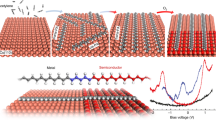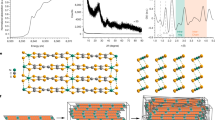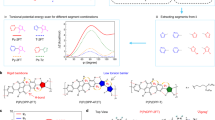Abstract
The electrical conductivity of conducting polymers results from mobile charge carriers introduced into the π-electron system through doping1,2. Because of the large infra-chain transfer integrals, the transport of charge is believed to be principally along the conjugated chains, with inter-chain hopping as a necessary secondary step. In conducting polymers, as in all metals and semiconductors, charge transport is limited by a combination of intrinsic electron–photon scattering and sample imperfection. Although relatively high conductivities (σ ≈ 1,000 S cm−1) have been reported for partially orientated and heavily doped polyacetylene1–3, the absence of a metal-like temperature dependence implies that the observed values are not intrinsic. In doped polyacetylene, (CH)x, electrical transport can be limited both by microscopic defects (leading to scattering and localization) and by the more macroscopic complex fibrillar morphology12 and associated interfibrillar contacts. Thus, with improvements in material quality, one might anticipate corresponding improvements in the electrical conductivity. Here we report the synthesis of polyacetylene with fewer sp3 defects than in material prepared by other methods. The higher-quality material exhibits substantially higher electrical conductivity; maximum values of >20,000 S cm−1 are obtained after doping with iodine. The conductivity has been measured as a function of temperature and pressure: at 0.48 K and 10 kbar, iodine-doped samples remain highly conducting (σ ≈ 9,000 S cm−1).
This is a preview of subscription content, access via your institution
Access options
Subscribe to this journal
Receive 51 print issues and online access
$199.00 per year
only $3.90 per issue
Buy this article
- Purchase on Springer Link
- Instant access to full article PDF
Prices may be subject to local taxes which are calculated during checkout
Similar content being viewed by others
References
Skotheim, T. J. (ed.) Handbook of Conducting Polymers (ed. Skotheim, T. J.) (Dekker, New York, 1986).
Etemad, S., Heeger, A. J. & MacDiarmid, A. G. A. Rev. Phys. Chem. 33, 443 (1982).
Gould, C. M. et al. Phys. Rev. B 23, 6820 (1981).
Shirakawa, H. & Ikeda, S. Synth. Met. 1, 175 (1980).
Naarmann, H. Synth. Met. 17, 223 (1987).
Moses, D., Denenstein, A., Pron, A., Heeger, A. J. & MacDiarmid, A. G. Solid St. Commun. 36, 219 (1980).
Park, Y. W., Denenstein, A., Chiang, C. K., Heeger, A. J. & MacDiarmid, A. G. Solid St. Commun. 29, 747 (1979).
Moraes, F., Chen, J., Chung, T.-C. & Heeger, A. J. Synth. Met. 11, 271 (1985).
Author information
Authors and Affiliations
Rights and permissions
About this article
Cite this article
Basescu, N., Liu, ZX., Moses, D. et al. High electrical conductivity in doped polyacetylene. Nature 327, 403–405 (1987). https://doi.org/10.1038/327403a0
Received:
Accepted:
Issue Date:
DOI: https://doi.org/10.1038/327403a0
This article is cited by
-
Soft bioelectronics for the management of cardiovascular diseases
Nature Reviews Bioengineering (2023)
-
A new path to highly conducting n-doped π-conjugated polymers
Science China Chemistry (2023)
-
Liquid metal-based plant electronic tattoos for in-situ monitoring of plant physiology
Science China Technological Sciences (2023)
-
A solution-processed n-type conducting polymer with ultrahigh conductivity
Nature (2022)
-
Quantifying charge carrier localization in chemically doped semiconducting polymers
Nature Materials (2021)
Comments
By submitting a comment you agree to abide by our Terms and Community Guidelines. If you find something abusive or that does not comply with our terms or guidelines please flag it as inappropriate.



